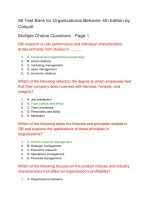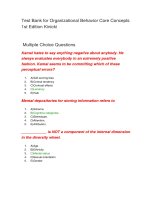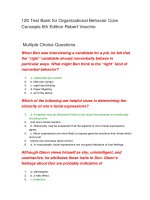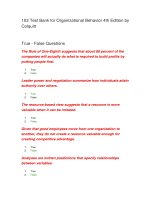Organizational behavior core concepts by kinicki chapter7
Bạn đang xem bản rút gọn của tài liệu. Xem và tải ngay bản đầy đủ của tài liệu tại đây (473.57 KB, 41 trang )
7
Organizational Behavior
core concepts
Decision Making: How
Individuals and Groups
Arrive at Decisions
7-2
McGraw-Hill/Irwin
Organizational Behavior, Core Concepts
Copyright © 2008 by the McGraw-Hill Companies, Inc. All rights reserved.
Learning Objectives
• Compare the rational model of decision
making with Simon’s normative model.
• Discuss knowledge management and
ways that companies increase
knowledge sharing.
• Explain the model of decision-making
styles and the stages of the creative
process.
7-3
Learning Objectives
• Summarize pros and cons of involving
groups in the decision-making process.
• Explain how participative management
affects performance.
• Describe techniques used to improve the
quality of group decisions
7-4
Models of Decision Making
• Decision making
– identifying and choosing solutions that lead
to a desired result
7-5
Models of Decision Making
• The Rational Model
– logical four-step approach to decision
making.
7-6
The Rational Model
1.
2.
3.
4.
7-7
Identifying the problem
Generating alternative solutions
Selecting a solution
Implementing and evaluating the
solution
Rational Model
• Identifying the Problem
– Problem – exists when the actual situation
and the desired situation differ
• Generating Solutions
– For routine decisions alternatives are readily
available through decision rules
7-8
Rational Model
• Selecting a Solution
– Want to maximize the expected utility of an
outcome
– People vary in their preferences for safety or
risk
– Ethics should be considered
7-9
Rational Model
• Selecting a Solution
– Evaluating alternatives assume they can be
judged according to some criteria
– Assumes valid criteria exists
– Each alternative can be compared to these
criteria
– Decision maker actually uses the criteria
7-10
Rational Model
• Implementing and Evaluating the
Solution
– After solution is implemented, the evaluation
phase is used to evaluate its effectiveness
– Optimizing – choosing the best possible
solution
7-11
Simon’s Normative Model
Decision making is characterized by:
1. Limited information processing
2. Use of judgmental heuristics
3. Satisficing
7-12
Simon’s Normative Model
• Bounded rationality
– constraints that restrict decision making
7-13
Simon’s Normative Model
Limited Information Processing
• Tendency to acquire manageable rather
than optimal amounts of information
• Difficult for managers to identify all
possible alternative solutions
7-14
Question?
What is a rule of thumb that people use to
reduce information processing
demands?
A. Decision maker
B. Judgmental heuristics
C. Judgmental verdict
D. Decision conclusion
7-15
Simon’s Normative Model
• Judgmental heuristics
– rules of thumb or shortcuts that people use
to reduce information processing demands.
7-16
Simon’s Normative Model
• Availability heuristic
– tendency to base decisions on information
readily available in memory.
• Representativeness heuristic
– tendency to assess the likelihood of an
event occurring based on impressions about
similar occurrences.
7-17
Simon’s Normative Model
• Satisficing
– choosing a solution that meets a minimum
standard
7-18
Dynamics of Decision Making
• Knowledge management
– implementing systems and practices that
increase the sharing of knowledge and
information throughout an organization
7-19
Forms of Knowledge
• Tacit knowledge
– information gained through experience that
is difficult to express and formalize.
• Explicit knowledge
– information that can be easily put into words
and shared with others.
7-20
General Decision Making Styles
• Decision making styles
– combination of how individuals perceive and
respond to information
7-21
General Decision Making Styles
• Value orientation
– reflects the extent to which an individual
focuses on either task and technical
concerns or people and social concerns
when making decisions
• Tolerance for ambiguity
– extent to which a person has a high need for
structure or control in his life
7-22
Decision Making Styles
7-23
Figure 7-1
Escalation of Commitment
• Escalation of
commitment
– sticking to an
ineffective course
of action too long
7-24
Escalation of Commitment
Psychological and Social Determinants
1. Tend to bias facts so that they support
previous decisions
2. Take more risks when a decision is
stated in negative terms
3. Get too ego-involved with the project
7-25









